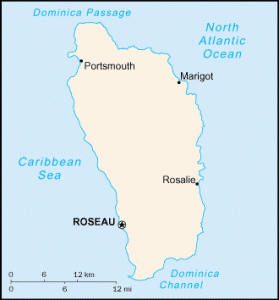Dominica
 In 2005, rugged, jungle-filled Dominica became the first nation to be certified by Green Globe 21 for sustainable development. Nature-oriented visitors appreciate Dominica’s rich culture and history, and this locale has a great deal to offer travelers with a quest for adventure. Located between Guadeloupe and Martinique, Dominica’s mountains soar to nearly 5,000 feet, yielding a thriving rainforest, hundreds of rivers and waterfalls, rare orchids and colorful birds. Geothermal activity results in colorful hot springs, bubbling mud pools, small geysers and Boiling Lake, the second largest lake of its kind in the world. Many of the sites are found in Morne Trois Pitons National Park, the Eastern Caribbean’s first a UNESCO World Heritage Site.
In 2005, rugged, jungle-filled Dominica became the first nation to be certified by Green Globe 21 for sustainable development. Nature-oriented visitors appreciate Dominica’s rich culture and history, and this locale has a great deal to offer travelers with a quest for adventure. Located between Guadeloupe and Martinique, Dominica’s mountains soar to nearly 5,000 feet, yielding a thriving rainforest, hundreds of rivers and waterfalls, rare orchids and colorful birds. Geothermal activity results in colorful hot springs, bubbling mud pools, small geysers and Boiling Lake, the second largest lake of its kind in the world. Many of the sites are found in Morne Trois Pitons National Park, the Eastern Caribbean’s first a UNESCO World Heritage Site.
Hikers can trek to Victoria Falls, and Middleham Falls, a narrow plume of water falling 200 feet from a cliff notch. A strenuous excursion to Morne Diablotin (Devil’s Mountain) reaps glimpses of two endemic Amazona parrots, the jaco and the sisserou. Non-hikers can ride the Rainforest Aerial Tram, which offers a 70-minute journey through the treetop canopy. Mountain biking, horseback riding, river tubing and jeep safaris are other ways of enjoying Dominica’s natural gifts.
The offshore marine environment is equally fascinating, as healthy reefs and marine life, extraordinary formations and 100-foot visibility draw scuba divers. Dominica’s waters host 22 species of whales and dolphins, making it a prime whale-watching destination throughout the winter. Beaches are mostly black sand, with a few golden strands in the northeast. The Dominica Watersports Association has hosted a week-long watersports event called DIVE FEST in July every year sine 1983. Dive Fest is very popular with locals and visitors and is a great time to secure good deals on dives!
For history lovers, the capital, Roseau and Fort Shirley are fun to explore. At the Kalinago Barana Aute, visitors can watch as Kalinago Indians carve the trunk of a Gommier tree into a canoe. Cultural performances, storytelling and “spiritual cleansings” are part of the outing. Tours of a rum distillery and the Rosalie slave plantation estate are also popular. Local restaurants serve predominantly native Creole cuisine; mountain chicken (frog legs) is the national dish. The World Creole Music Festival takes place in October, and Mas Dominik, the island’s carnival, features calypso and steel pan competitions, a soca music festival, jump-ups and a costume parade.
General Description:
| Language | English is the official language, spoken with a melodic French lilt, but a large portion of the population speaks Kwèyòl (Creole), with a few northern villages speaking Kokoy. |
| Government | Parliamentary democracy |
| Location | Dominica is located in the eastern Caribbean, between the French Islands of Guadeloupe (which lies to the north) and Martinique (which lies to the south). |
| Climate and Temperature | Daytime temperatures vary between 75 & 90 degrees F. Temperataures may drop in the evenings and at higher altitudes. Coolest months are December to March. |
| Driving | Driving is on the left-hand side of the road, and a driver’s license is required. |
| Currency | E.C. Dollar |
| Dominica – Capital | Roseau |
| Airport: | Canefield & Melville Hall |
| Land Area | 289 sq. miles |
| Population | Approx 70,000 |
| Ministry of tourism | (767) 448 2045 |
| Website | http://www.dominica.dm/ |

